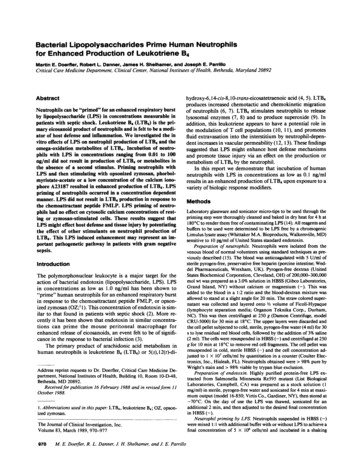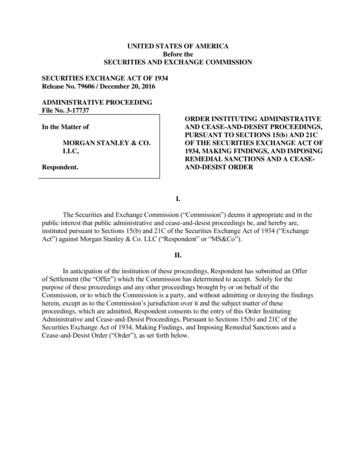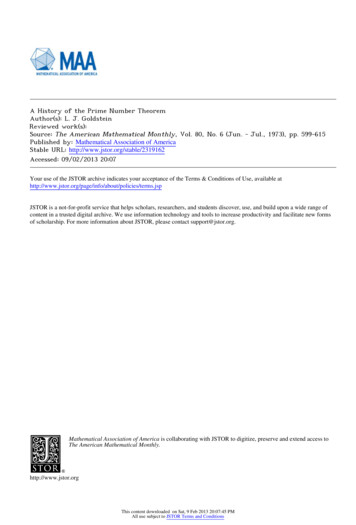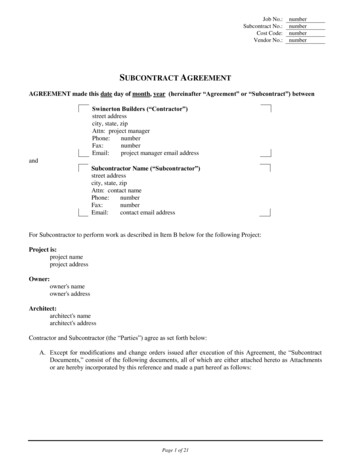
Transcription
Bacterial Lipopolysaccharides Prime Human Neutrophilsfor Enhanced Production of Leukotriene B4Martin E. Doerfler, Robert L. Danner, James H. Shelhamer, and Joseph E. ParrilloCritical Care Medicine Department, Clinical Center, National Institutes of Health, Bethesda, Maryland 20892AbstractNeutrophils can be "primed" for an enhanced respiratory burstby lipopolysaccharide (LPS) in concentrations measurable inpatients with septic shock. Leukotriene B4 (LTB4) is the primary eicosanoid product of neutrophils and is felt to be a mediator of host defense and inflammation. We investigated the invitro effects of LPS on neutrophil production of LTB4 and theomega-oxidation metabolites of LTB4. Incubation of neutrophils with LPS in concentrations ranging from 0.01 to 100ng/ml did not result in production of LTB4 or metabolites inthe absence of a second stimulus. Priming neutrophils withLPS and then stimulating with opsonized zymosan, phorbolmyristate-acetate or a low concentration of the calcium ionophore A23187 resulted in enhanced production of LTB4. LPSpriming of neutrophils occurred in a concentration dependentmanner. LPS did not result in LTB4 production in response tothe chemoattractant peptide FMLP. LPS priming of neutrophils had no effect on cytosolic calcium concentrations of resting or zymosan-stimulated cells. These results suggest thatLPS might effect host defense and tissue injury by potentiatingthe effect of other stimulants on neutrophil production ofLTB4. This LPS induced enhancement may represent an important pathogenetic pathway in patients with gram negativesepsis.IntroductionThe polymorphonuclear leukocyte is a major target for theaction of bacterial endotoxin (lipopolysaccharide, LPS). LPSin concentrations as low as 1.0 ng/ml has been shown to"prime" human neutrophils for an enhanced respiratory burstin response to the chemoattractant peptide FMLP, or opsonized zymosan (OZ;' 1). This concentration of endotoxin is similar to that found in patients with septic shock (2). More recently it has been shown that endotoxin in similar concentrations can prime the mouse peritoneal macrophage forenhanced release of eicosanoids, an event felt to be of significance in the response to bacterial infection (3).The primary product of arachidonic acid metabolism inhuman neutrophils is leukotriene B4 (LTB4) or 5(s), 12(r)-diAddress reprint requests to Dr. Doerfler, Critical Care Medicine Department, National Institutes of Health, Building 10, Room 10-D-48,Bethesda, MD 20892.Receivedfor publication 16 February 1988 and in revisedform 11October 1988.1. Abbreviations used in this paper: LTB4, leukotriene B4; OZ, opsonized zymosan.The Journal of Clinical Investigation, Inc.Volume 83, March 1989, 970-977970M. E.Doerfler, R. L. Danner, J. H. Shelhamer, and J. E. Parrillohydroxy-6,14-cis-8, l0-trans-eicosatetraenoic acid (4, 5). LTB4produces increased chemotactic and chemokinetic migrationof neutrophils (6, 7). LTB4 stimulates neutrophils to releaselysosomal enzymes (7, 8) and to produce superoxide (9). Inaddition, this leukotriene appears to have a potential role inthe modulation of T cell populations (10, 1 1), and promotesfluid extravasation into the interstitium by neutrophil-dependent increases in vascular permeability (12, 13). These findingssuggested that LPS might enhance host defense mechanismsand promote tissue injury via an effect on the production ormetabolism of LTB4 by the neutrophil.In this report we demonstrate that incubation of humanneutrophils with LPS in concentrations as low as 0.1 ng/mlresults in an enhanced production of LTB4 upon exposure to avariety of biologic response modifiers.MethodsLaboratory glassware and sonicator micro-tips to be used through thepriming step were thoroughly cleaned and baked in dry heat for 4 h at180'C to render them free ofcontaminating LPS (14). All reagents andbuffers to be used were determined to be LPS free by a chromogenicLimulus lysate assay (Whittaker M.A. Bioproducts, Walkersville, MD)sensitive to 10 pg/ml of United States standard endotoxin.Preparation of neutrophils. Neutrophils were isolated from thevenous blood of normal volunteers using standard techniques as previously described (15). The blood was anticoagulated with 5 U/ml ofsterile pyrogen-free, preservative free heparin (porcine intestine; Weddel Pharmaceuticals, Wrexham, UK). Pyrogen-free dextran (UnitedStates Biochemical Corporation, Cleveland, OH) of 200,000-300,000mol wt was prepared as a 3.0% solution in HBSS (Gibco Laboratories,Grand Island, NY) without calcium or magnesium (-). This wasadded to the blood in a 1:2 ratio and the blood-dextran mixture wasallowed to stand at a slight angle for 20 min. The straw colored supernatant was collected and layered onto 1/2 volume of Ficoll-Hypaque(lymphocyte separation media; Organon Teknika Corp., Durham,NC). This was then centrifuged at 250 g (Damon Centrifuge, modelCRU-5000) for 30 min at 1 8 C. The upper layers were discarded andthe cell pellet subjected to cold, sterile, pyrogen-free water (4 ml) for 30s to lyse residual red blood cells, followed by the addition of 3% saline(2 ml). The cells were resuspended in HBSS (-) and centrifuged at 250g for 10 min at 18'C to remove red cell fragments. The cell pellet wasresuspended in cold, sterile HBSS (-) and the cell concentration adjusted to 1 X 107 cells/ml by quantitation in a counter (Coulter Electronics, Inc., Hialeah, FL). Neutrophils obtained were 98% pure byWright's stain and 98% viable by trypan blue exclusion.Preparation of endotoxin. Highly purified protein-free LPS extracted from Salmonella Minnesota Re595 mutant (List BiologicalLaboratories, Campbell, CA) was prepared as a stock solution (1mg/ml) in sterile, pyrogen-free water and sonicated for 4 min at maximum output (model 16-850; Virtis Co., Gardiner, NY), then stored at-70 C. On the day of use the LPS was thawed, sonicated for anadditional 2 min, and then adjusted to the desired final concentrationin HBSS (-).Neutrophil priming by LPS. Neutrophils suspended in HBSS (-)were mixed 1:1 with additional buffer with or without LPS to achieve afinal concentration of 5 X 106 cells/ml and incubated in a shaking
water bath according to the method of Guthrie et al. (1). In mostexperiments 1 ml of the cell mixture was used. 4 ml of the cell mixturewas used to increase the sensitivity of the assay methods in one groupof experiments using OZ as a stimulant for LTB4 production. Anincubation time of 60 min was used in initial experiments based on thepreviously reported optimal incubation time for priming for enhancedsuperoxide generation (1, 15). Subsequently experiments were performed with the incubation times varied to determine the optimumduration of LPS exposure. After incubation, cells were examined microscopically to be certain that clumping had not occurred. Trypanblue exclusion always showed the neutrophils to be 92% viable afterincubation. Superoxide production was determined concurrently insome experiments to verify LPS priming of the respiratory burst aspreviously reported (1, 15). Superoxide was measured using a cytochrome c assay as previously described (15).Preparation of reagents. Ionophore A23187 (Ionophore; Calbiochem-Behring Corp., La Jolla, CA) was reconstituted from powder inethanol and sonicated at maximal output for 2 min and then stored at-20'C. On the day of use the ionophore was again sonicated, dilutedto final concentration in HBSS (-), and sonicated again.Phorbol myristate acetate (PMA; Sigma Chemical Co., St. Louis,MO) was stored in initial stock solution (1 mg/ml) in dimethyl sulfoxide (DMSO; Sigma Chemical Co.) at -20'C. On the day of use thePMA stock solution was diluted to the desired concentration withHBSS (-).OZ was prepared by first boiling zymosan (Sigma Chemical Co.) in0.9% NaCl to get a suspension free ofclumping of the particles. This iscooled to room temperature and washed four times in sterile salinethen incubated with fresh human serum at 370C for 20 min (Lab-LineInstruments, Melrose Park, IL; 16). After centrifugation and fourwashings the OZ was suspended in 0.9% NaCI at 50 mg/ml.FMLP (Sigma Chemical Co.) was stored at -70'C in HBSS (-)and 10% DMSO at a final concentration of 0.1 mM. On the day of usethe FMLP stock solution was diluted to the desired concentration withHBSS (-).Fura 2/AM (Calbiochem) was stored at -20'C in DMSO at a finalconcentration of 10 mM.Stimulation ofprimed cells for LTB4 generation. After the incubation with LPS, calcium and magnesium salts were added to the cellsuspension in the concentrations necessary to achieve a final solutionequivalent to HBSS ( ). Ionophore, OZ, PMA, or FMLP was thenadded, and the cell mixture was incubated for the desired time. Theconcentration of DMSO never exceeded 0.0 1%, and the concentrationof ethanol was never greater than 0.01% in the final solution. Themixture was vortexed frequently to maintain the cells in suspension.Incubations were terminated in most experiments with the addition of1.5 volumes of iced ethanol (HPLC grade; Aldrich Chemical Co.,Milwaukee, WI) and the mixture refrigerated at -200C for at least I h.Intracellular and extracellular LTB4 were determined in the experiments using 4 ml of the neutrophil suspension and OZ as the secondstimulant. The incubation was terminated by cooling at 4 C and centrifugation at 500 g. The supernatant was decanted and the cell pelletresuspended in 100% methanol (HPLC grade; Burdick-Jackson Laboratories, Muskegon, MI) for 12 h at 4 C (17). Prostaglandin B2 (200mg; Sigma Chemical Co.) was added as an internal standard to allexperiments ( 18).Extraction of eicosanoids. Polypropylene labware was usedthroughout the extraction process to avoid losses of the eicosanoids toglass surfaces. The cell mixture was centrifuged at 500 g (Accuspin;Beckman Instruments, San Ramon, CA) and the supernatant extracted on octadecyl-silane (ODS) C18 cartridges (Sep-pak; WatersAssociates, Milford, MA; 18). Individual cartridges were prepared with20 ml of ethanol followed by 5 ml of water (HPLC grade, FisherScientific, Pittsburgh, PA) Samples were diluted to 10% ethanol, andthe pH adjusted to 3.2 with concentrated HCI. Cartridges were elutedsequentially with 5.0 ml of 10% (vol/vol) HPLC grade ethanol, 5 ml ofHPLC grade water, 10 ml of petroleum ether (Fisher Scientific) and 4.0ml of methyl-formate/(Eastman-Kodak Co., Rochester, NY; redis-tilled; 18) ethanol/acetic acid (90:10:0.02). The methyl-formate fraction is saved and evaporated to dryness under steady flow nitrogen gas(Evapo-rac; Cole-Parmer Medical Instruments, Chicago, IL) and resuspended in mobile phase (see below) for analysis by HPLC. Theextraction efficiency for PGB2 was 94.0 3.0% (n 10), for LTB4 was74.0 2.5% (n 10) and for radiolabeled LTB4 incubated with neutrophils (18) was 81.8 0.2%. The recovery of PGB2 was used to correct forvariances in recovery of LTB4 and the metabolites in individual experiments (18).High performance liquid chromatography. A Beckman model 344liquid chromatography system was used with dual pumps (model 114),an autosampler (model 506), and a variable wavelength ultravioletdetector (model 164) at 280 nM. An Ultrasphere C18 (Beckman) column (4.7 mm X 250 mm) with 5-um particle size, was used along withan Ultrasphere C18 precartridge (4.7 mm X 45 mm). The gradientprogram of Shak (18) was used with mobile phase A: methanol/acetonitrile/water/acetic acid (30:25:45:0.02), and mobile phase B: methanol/acetonitrile (75:25). LTB4 standards, PGB2, and [3HJLTB4 (Dupont, New England Nuclear, Boston, MA) were used as standards.LTB4-COOH and LTB4-OH were prepared from LTB4 and [3H]LTB4as described (18), and used for peak identification of LTB4 metabolites.Chromatogram plots and integrations for peak areas were accomplished using a Chromatopac C-RI B data processor (Shimadzu Corp.,Kyoto, Japan). Concentrations of LTB4 and metabolites were obtainedfrom the integrated areas by comparison to a standard curve with R2 0.9977, n 5, prepared under identical conditions. The accuracy ofthe standard curve was verified by comparison against a molar extinction coefficient in methanol at 281 nm of 39,500 as previously defined(19). The lower limits of detection of LTB4 was 1.0 ng. Using 5 X 106cells/experiment, as little as 0.2 ng/106 cells could be detected.The presence of significant amounts of contaminating 5,12,DiHeteor 5(s), 12(s)-dihydroxy-6,14-cis-8, I0-trans-eicosatetraenoic acid (20)was ruled out by chromatography of the methyl esters using the abovesystem with an ultrasphere Si (Beckman) column (4.7 mm X 250 mm)and precolumn (4.7 mm X 45 mm) with 5-,um bead size. Isocraticelution with hexane/2-propanol at 2.0 ml/min was performed as previously described (18, 21, 22). 5,12,DiHete never exceeded 3% of totalLTB4.Experiments were performed using four times the number of neutrophils to increase the sensitivity of the assay system for OZ stimulated LTB4 production. The LTB4 and metabolite peaks eluting fromthe HPLC were collected and further analyzed by ultraviolet spectroscopy (model HP 89500; Hewlett-Packard Corp., Palo Alto, CA) andfound to have peak absorption at 270 nm with shoulders at 260 and280 nm as previously described (20). In addition, a portion of thecollected peak eluting as LTB4 was further characterized and quantitated as LTB4 by radioimmunoassay (LTB4 antisera; Advanced Magnetics, Cambridge, MA)Spectrofluorimetric analysis of intracellular calcium. Neutrophilswere loaded with Fura 2 by addition of I gM Fura 2/AM to the cellsuspension (1 X 107 cells/ml) for 1 h at 37 C in a shaking water bath(23). After incubation the cells were centrifuged at 200 g for 10 min toremove extracellular dye and resuspended in HBSS (-). After loadingthe cell mixture was divided and portions analyzed fluorimetrically orincubated for 60 min without LPS or with LPS 10 ng/ml. Followingthis incubation the mixture was again centrifuged at 200 g for 10 minand the supernatant decanted to remove any Fura 2 that may haveleaked from the cells during the priming process. The cell mixture wasthen analyzed for baseline calcium concentration and followed by theaddition of calcium and magnesium salts necessary to achieve a finalsolution equivalent to HBSS ( ). After equilibration calcium concentrations are again determined followed by OZ stimulation.Analysis was carried out using a luminescence spectrometer(LS-SB; Perkin-Elmer Corp., Norwalk, CT) in a wavelength scanningmode programmed with excitation wavelengths of 340 and 380 nmand an emission wavelength of 510 nm. Repetitive scans were performed every 30 s following the addition of OZ for 4 min and again at15, 30, and 45 min in some experiments. Cells were maintained atLeukotriene B4 Production by Endotoxin Primed Human Neutrophils971
370C by a circulating water bath and continually stirred by a smallmagnetic stirring bar. Autofluorescence was determined for equivalentnumbers of neutrophils not loaded with Fura 2 in the presence andabsence of OZ and subtracted from individual measurements of fluorescence to assure that the signal represented only intracellularFura 2 (23).Calcium concentrations were determined using the followingequation; (Ca2 ) Kd * ((R - Rmin)/(Rmax- R)) * B (23) with Rmin andRmax determined for each individual experiment as suggested by Scanlon et al to account for incomplete deesterification of Fura 2/AM (23).Kd 224 nM at 370C, R 340/380 ratio, and B is the ratio of Fura 2fluorescence at 380 nm in 0 and saturating calcium.Statistical analysis. Parametric comparisons of the data generatedat each concentration of LPS were done for each type and concentration of stimulant used. Data from experiments producing curves withmany values was first converted to a single value based on the areaunder the curve. Data from experiments with a single end pointwere used in that form. Comparisons were than made using one-sided ttests and Bonferroni's inequality to adjust for multiple comparisons(24). All reported experiments were done with n 5 except the calciumdeterminations where three separate experiments were each done intriplicate.ResultsLPS at which a significant enhancement of LTB4 release couldbe demonstrated was 0.1 ng/ml. In the absence of the secondstimulus there was no LTB4 or metabolites detected in anyexperiment.In addition to finding a difference in the amounts and ratesof release of LTB4 and metabolites there was a marked difference in the ratio of LTB4 to metabolites between LPS-primedand unprimed neutrophils. The LTB4 produced by cells incubated in the absence of LPS was almost entirely comprised ofmetabolites with a maximum of 15% being LTB4 even at theearliest time points. In contrast, cells incubated in the presenceof LPS (10 ng/ml) released up to 50% of the total as LTB4before metabolism (Fig. 2).Human neutrophils maximally produce LTB4 in responseto ionophore at a concentration of 1.0 ,ug/ml (26). At thisconcentration of ionophore, LPS-induced priming of neutrophils could not be demonstrated.The effect ofduration ofincubation on LPS-induced neutrophilpriming. The effect of incubation duration on priming wasstudied. The incubation period associated with maximalpriming of the neutrophil by LPS was 60 min. No effect wasseen at 0 min; 68 6% of maximum was seen at 30 min; and38 8% of maximal at 90 min. This decrease at 90 min wasLTB4 production by LPS-primed neutrophils stimulated withionophore A23187. The most potent of the available stimulifor the generation of LTB4 by the neutrophil are the calciumionophores (25, 26). In the presence of ionophore at a concentration of 0.05 Ag/ml, neutrophils incubated in the absence ofLPS produced 8.2 2.4 ng of LTB4 per million cells over 60min. In contrast the cells incubated with LPS produced greateramounts of LTB4 in a concentration-dependent manner withthe maximal generation being more than three times baselineproduction (26.6 2.4 ng/106 cells) at an LPS concentration of10 ng/ml (Fig. 1). The time at which the presence of eitherLTB4 or the metabolites could be demonstrated was earlier inthe LPS-treated cells, and the rate of production was also in-significantly decreased from maximum (P 0.02).LPS-inducedprimingfor enhanced release ofLTB4 by OZ,PMA, or FMLP-stimulated neutrophils. OZ-stimulated neutrophils produce LTB4 but in much smaller quantities thanthat produced with stimulation by the calcium ionophores (25,26). Neutrophils incubated in the absence of LPS and thenstimulated with OZ produced barely detectable amounts ofLTB4, 0.2 0.2 ng/106 cells, with all of the LTB4 present as thehydroxyl and carboxyl metabolites. Cells incubated in thepresence of LPS and then stimulated with OZ produced significantly greater amounts of LTB4. Priming with 10 ng/ml LPScreased. There was no apparent difference in the duration ofproduction of LTB4 in any of the groups. The concentration of30254035z30 -o- 25V3sD,2015CC,mWVI75 a10Figure 1. Effect of LPSon ionophore A23 187(0.05 ,g/ml) inducedproduction of LTB4 andmetabolites by neutrophils. Neutrophils wereincubated in HBSS (-)alone (-) orwith LPSfor 60 min at 37 C.LPS, 0.01 ng/ml (A); 0.1ng/ml (o); 1.0 ng/ml(o); 10 ng/ml (v); and5 15 30l00 ng/ml (o). CaCl2,60and MgSO4MgCl2,TIME (minutes)salts were added in appropriate amounts to have a final solution equivalent to HBSS ( )and then stimulated with ionophore and incubated at 37 C. Incubations were terminated at predetermined time points by addition of1.5 vol iced ethanol followed by addition of 200 ng PGB2 as an internal standard. The cells were pelleted by centrifugation and the supernatant was extracted on ODS C 1 8 cartridges for analysis by RPHPLC. Values are expressed as the total of LTB4 and metabolitespresent in the supernatant and are means of five separate expenments SEM. P 0.02 for LPS concentrations 20.1 ng/ml.5972M. E.rDoerfler, R. L. Danner, J. H. Shelhamer, and J. E. ParrilloCDLTB4 COOHElLTB4 OHNATIVE LTB4a2015FI-CT-plop5F-M- 5-- I- 10 1530INTIMEMINUTESi60Figure 2. Comparison of the release of LTB4 vs metabolites by neutrophils incubated in HBSS (-) alone or LPS (10 ng/ml). Neutro-phils were incubated for 60 min at 370C and then stimulated withionophore A23 187 (0.05 ,g/ml). Incubations were terminated at predetermined time points by addition of 1.5 vol iced ethanol. Valuesrepresent the means of five separate experiments. The results of experiments done in the absence of LPS are noted with (-) and experiments done in the presence of LPS (10 ng/ml) are represented with ( ).
resulted in production of 2.8 0.8 ng/106 cells (Fig. 3). TheLPS-primed neutrophils produced native as well as metabolized LTB4 (Fig. 4). The lowest concentration ofLPS necessaryto result in enhanced production of LTB4 under these conditions was 0.1 ng/ml. Intracellular retention of native LTB4 wasnot found in experiments designed to differentiate cell associated from secreted LTB4. This is in contrast to what has beenpreviously described for neutrophils stimulated with unopsonized zymosan (17) and does not appear to be the reason for theabsence of native LTB4 from the unprimed neutrophils.FMLP does not cause LTB4 production by neutrophils inthe absence of exogenous arachidonate (25, 26). Priming withLPS in concentrations ranging from 0.01 to 100 ng/ml, did notresult in the production of detectable amounts of LTB4 ormetabolites by neutrophils incubated with FMLP 10-6 M forup to 60 min.PMA, which is reported to act via enhanced activity ofprotein kinase C (27, 28), has been reported to prime neutrophils for enhanced production of LTB4 (29, 30). Stimulationwith PMA (1lg/ml) alone for up to 5- 10 min however was notsufficient for LTB4 production in these and other experiments(25, 29, 30). We found that incubating neutrophils with PMA(1lg/ml) for as long as 60 min did not result in production ofLTB4 or metabolites. Significant amounts of LTB4 metaboliteswere however, detectable from neutrophils preincubated withLPS and then stimulated with PMA (Table I). The duration ofincubation with PMA in these experiments was 60 min. All of3.Orr1nCl) ADOcDI2.00!Z--mC1.51.0nI- NATIVE LTB 4CD2.01.5-I-505- -10 153060TIME IN MINUTES 90Figure 4. Comparison of the release of LTB4 vs. metabolites by neutrophils incubated in HBSS (-) alone or LPS (10 ng/ml). Neutrophils were incubated for 60 min at 37 C and then stimulated withOZ (10 mg/ml). Incubations were terminated at predetermined timepoints by addition of 1.5 vol iced ethanol. Values represent themeans of five separate experiments except the 90-min values whichrepresent the means of four separate experiments. The results of experiments done in the absence of LPS are noted with (-) and experiments done in the presence of LPS (10 ng/ml) are represented with ( ).the LTB4 detected was present as the metabolites. The lowestconcentration of LPS necessary to consistently produce thiseffect is 0.1 ng/ml.OZ effects on intracellular calcium in primed and unprimed neutrophils. Calculated intracellular calcium concentrations immediately after the incubation period with Fura2/AM were essentially zero. Following the addition of calciumto the mixture the concentration rose to 40 nM in both controland LPS-treated cells. Upon addition of zymosan to the mixture there was a rise in the calcium levels plateauing at 90-120s (Fig. 5). This is consistent with previously reported data (3 1).There was no significant difference in baseline calcium or cal-Table I. Effect of LPS on PMA (I gtg/ml) Induced Productionof LTB4 and Metabolites by NeutrophilsV.301TIME (minutes)Figure 3. Effect of LPS on OZ (10 mg/ml) induced production ofLTB4 and metabolites by neutrophils. Neutrophils were incubated inHBSS (-) alone (-) or with LPS for 60 min at 37 C. LPS, 0.01ng/ml (A); 0.1 ng/ml (o); 1.0 ng/ml (o); 10 ng/ml (v); and 100 ng/ml(0). CaCl2, MgCl2, and MgSO4 salts were added in appropriateamounts to have a final solution equivalent to HBSS ( ) and thenstimulated with ionophore and incubated at 37 C. Incubations wereterminated at predetermined time points by addition of 1.5 vol icedethanol followed by addition of 200 ng PGB2 as an internal standard.The cells were pelleted by centrifugation and the supernatant was extracted on ODS C18 cartridges for analysis by RP-HPLC. The peakseluting as LTB4 and metabolites were verified quantitatively forLTB4 by RIA and qualitatively as LTB4 and metabolites by ultraviolet spectroscopy in the control and 1 0-ng/ml groups. Values are expressed as the total of LTB4 and metabolites present in the supernatant and are means of five separate experiments SEM except for the90-min point, which represents four experiments. P 0.02 for LPSconcentrations .0.1 ng/ml.LPSLTB4ng/mlng/106 PMN0.000.010.101.0010.01000.18 0.080.21 0.071.24 0.142.56 0.332.74 0.232.94 0.24Neutrophils were incubated in HBSS (-) alone or LPS for 60 min at370C. CaCl2, MgCl2, and MgSO4 salts were added in appropriateamounts to have a final solution equivalent to HBSS ( ) and thenstimulated with PMA and incubated at 370C. Incubations were terminated at 60 min by addition of 1.5 vol iced ethanol followed byaddition of 200 ng PGB2. Values are expressed as the total of LTB4and metabolites present in the supernatant and are means of fiveseparate experiments SEM. P 0.02 for LPS . 0.1 ng/ml compared to control, P 0.05 for LPS 2 1.0 ng/ml compared to LPS 0.1 ng/ml.Leukotriene B4 Production by Endotoxin Primed Human Neutrophils973
2 200czA0\150 -oI Ic-z0100zoO.IoI.0.I-002 50 lH-J07l0O'I I I0IIl30 60 90 120 150 180 210 240TIME (seconds)Figure 5. Effect of LPS on changes in calcium concentration in neutrophils upon stimulation with opsonized zymosan. Neutrophils wereincubated in HBSS (-) alone (e) or LPS 10 ng/ml (o) for 60 min at370C. CaCl2, MgCl2, and MgSO4 salts were added in appropriateamounts to have a final solution equivalent to HIBSS ( ) and thenstimulated with OZ 10 mg/ml. Calcium concentration was calculatedfrom the ratio of fluorescent intensities measured at 340- and 380nM excitation, 5 10-nM emission, using the standard procedure described under Methods. T 0' represents measurements made beforeaddition of calcium and magnesium salts to the cell suspension. T 0 represents measurements made prior to the addition of OZ. Thecalcium concentration increased rapidly plateauing at 90-120 s andthen slowly drifted downward but remained elevated with levels at45 min of 85 and 90 nM for control and primed cells, respectively. cium flux between cells primed with LPS and unprimed cells.Frequent measurements were made for only the first 5 min,however periodic measurements made over the next 45 minshowed the calcium level slowly drifting downward but to haveremained elevated with levels at 45 min of 85 and 90 nM forcontrol and primed cells, respectively.DiscussionThe results of these studies show that human neutrophils canbe primed for enhanced production and release of LTB4 byexposure to picogram quantities of LPS. The time of incubation with LPS necessary for maximum enhancement of LTB4production is 60 min. There is a significant effect seen at 30min and a decreasing effect with prolonged incubation. Anidentical time course was found in studies of priming for superoxide generation (data not shown). The most potent stimulifor the production of LTB4 by neutrophils are the calciumionophores (25, 26). Incubation of human neutrophils withthe ionophore at a concentration of 1.0 ,g/ml results in maximal production of LTB4. Enhancement of LTB4 productionby LPS is not seen when the cells are maximally stimulated.Using a much lower concentration of ionophore (0.05 ,ug/ml),as little as 0.1 ng/ml of LPS is necessary to significantly enhance the production of LTB4 by neutrophils. LPS alone doesnot result in the release of detectable amounts of LTB4 by theneutrophils.The effect of LPS on the generation of LTB4 by ionophore-stimulated neutrophils is similar to increasing the con974M. E. Doerfler, R. L. Danner, J. H. Shelhamer, and J. E. Parrillocentration of ionophore. Prior incubation with LPS does notincrease LTB4 production to a higher maximum. This suggeststhat the mechanism by which LPS is affecting LTB4 production might occur by modulation of cytosolic free calcium concentrations or by altering the activity of a calcium sensitiveenzyme system.OZ stimulation of neutrophils has been shown to result inthe production of very small amounts of LTB4 (25, 26). Theeffect of OZ stimulation of neutrophils has been shown to be,at least in part, due to an increase in cytosolic free calcium(31). In the macrophage there also appears to be a calcium-dependent zymosan effect on phospholipase C, which may play arole in arachidonic acid release (32, 33). Our studies confirmthat OZ stimulation of neutrophils results in an increase inintracellular calcium. We have also found that OZ stimulationof neutrophils in the absence of extracellular calcium does notresult in LTB4 production (data not shown). We did not findany significant effect of priming with LPS on this alteration incalcium levels. Coupled with the ionophore data this wouldseem to implicate a calcium dependent enzyme system as thelikely site of action for LPS priming. There are multiple potential sights for this type of effect in the neutrophil includingthe phospholipases A2 and C (34), protein kinase C (35), phosphoinositol metabolism (36, 37), and 5-lipoxygenase (38). Allof these systems have been implicated as being responsible forthe differences in LTB4 production resulting from differentstimuli.The chemo-attractant tripeptide FMLP is reported to result in production of LTB4 by neutrophils only in the presenceof a marked excess of arachidonate (25, 26). Arachidonic acidat these concentrations has been postulated to be effectingeither phospholipase C (26) or 5-lipoxygenase (25) activity directly, in addition to acting as substrate. FMLP acts at least inpart by producing an increase in cytosolic free calcium whichis brief and not sustained (39, 40) and also appears t
Martin E. Doerfler, RobertL. Danner,JamesH. Shelhamer, andJosephE. Parrillo Critical CareMedicineDepartment, Clinical Center, NationalInstitutes ofHealth, Bethesda, Maryland20892 Abstract rst by lipopolysaccharide (LPS) in concentrations mea


![Algorithms AppendixI:ProofbyInduction[Sp’16]](/img/13/98-induction.jpg)







